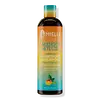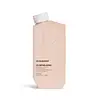What's inside
What's inside
 Key Ingredients
Key Ingredients

 Benefits
Benefits

 Concerns
Concerns

 Ingredients Side-by-side
Ingredients Side-by-side

Water
Skin ConditioningCocamidopropyl Betaine
CleansingSodium Methyl 2-Sulfolaurate
CleansingDisodium 2-Sulfolaurate
CleansingCocamidopropyl Hydroxysultaine
CleansingDisodium Cocoamphodipropionate
CleansingAloe Barbadensis Leaf Juice
Skin ConditioningPolyquaternium-10
Citric Acid
BufferingGlycerin
HumectantPanthenol
Skin ConditioningButylene Glycol
HumectantLamium Album Flower Extract
AstringentPinus Sylvestris Cone Extract
MaskingHedera Helix Extract
AntimicrobialSodium Chloride
MaskingMangifera Indica Seed Butter
Skin ConditioningVaccinium Myrtillus Fruit Extract
Skin ConditioningSaccharum Officinarum Extract
MoisturisingAcer Saccharum Extract
Skin ConditioningCitrus Aurantium Dulcis Fruit Extract
MaskingCitrus Limon Fruit Extract
MaskingArctium Lappa Root Extract
Skin ConditioningAnthemis Nobilis Flower Extract
MaskingRosmarinus Officinalis Leaf Extract
AntimicrobialLavandula Angustifolia Oil
MaskingMelaleuca Alternifolia Leaf Oil
AntioxidantAlgae Extract
EmollientOcimum Americanum Leaf Oil
MaskingPhenoxyethanol
PreservativeBenzoic Acid
MaskingEthylhexylglycerin
Skin ConditioningGlycereth-2 Cocoate
EmulsifyingParfum
MaskingWater, Cocamidopropyl Betaine, Sodium Methyl 2-Sulfolaurate, Disodium 2-Sulfolaurate, Cocamidopropyl Hydroxysultaine, Disodium Cocoamphodipropionate, Aloe Barbadensis Leaf Juice, Polyquaternium-10, Citric Acid, Glycerin, Panthenol, Butylene Glycol, Lamium Album Flower Extract, Pinus Sylvestris Cone Extract, Hedera Helix Extract, Sodium Chloride, Mangifera Indica Seed Butter, Vaccinium Myrtillus Fruit Extract, Saccharum Officinarum Extract, Acer Saccharum Extract, Citrus Aurantium Dulcis Fruit Extract, Citrus Limon Fruit Extract, Arctium Lappa Root Extract, Anthemis Nobilis Flower Extract, Rosmarinus Officinalis Leaf Extract, Lavandula Angustifolia Oil, Melaleuca Alternifolia Leaf Oil, Algae Extract, Ocimum Americanum Leaf Oil, Phenoxyethanol, Benzoic Acid, Ethylhexylglycerin, Glycereth-2 Cocoate, Parfum
Water
Skin ConditioningSodium Methyl 2-Sulfolaurate
CleansingSodium Cocoyl Isethionate
CleansingCocamidopropyl Hydroxysultaine
CleansingDisodium 2-Sulfolaurate
CleansingPEG-2 Cocamide
EmulsifyingCocamidopropyl Betaine
CleansingPEG-150 Distearate
EmulsifyingPanthenol
Skin ConditioningZingiber Officinale Root Extract
MaskingUrtica Dioica Extract
AstringentOleanolic Acid
Skin ConditioningAesculus Hippocastanum Seed Extract
Skin ConditioningEuterpe Oleracea Fruit Extract
Bambusa Vulgaris Leaf/Stem Extract
HumectantOryza Sativa Bran Oil
EmollientSilk Amino Acids
HumectantRice Amino Acids
Skin ConditioningKeratin Amino Acids
Skin ConditioningAloe Barbadensis Leaf Juice
Skin ConditioningCreatine
Skin ConditioningApigenin
AntioxidantBiotinoyl Tripeptide-1
Lactic Acid
BufferingZinc Picolinate
SoothingGlycerin
HumectantIsopropyl Alcohol
SolventButylene Glycol
HumectantPropanediol
SolventButyloctanol
HumectantDicetyldimonium Chloride
EmulsifyingSilicone Quaternium-16
Skin ConditioningPPG-26-Buteth-26
Skin ConditioningGlycol Distearate
EmollientGuar Hydroxypropyltrimonium Chloride
Skin ConditioningUndeceth-11
EmollientPEG-120 Methyl Glucose Trioleate
CleansingSteareth-4
EmulsifyingPEG-40 Hydrogenated Castor Oil
EmulsifyingUndeceth-5
EmulsifyingPolyquaternium-7
Polyquaternium-10
Disodium EDTA
Trisodium Hedta
Phenoxyethanol
PreservativeEthylhexylglycerin
Skin ConditioningChlorphenesin
AntimicrobialSorbic Acid
PreservativeBenzoic Acid
MaskingPotassium Sorbate
PreservativeSodium Benzoate
MaskingLactobacillus Ferment
Skin ConditioningLeuconostoc/Radish Root Ferment Filtrate
AntimicrobialIodopropynyl Butylcarbamate
PreservativeCitric Acid
BufferingParfum
MaskingBenzyl Benzoate
AntimicrobialBenzyl Salicylate
PerfumingHydroxycitronellal
PerfumingWater, Sodium Methyl 2-Sulfolaurate, Sodium Cocoyl Isethionate, Cocamidopropyl Hydroxysultaine, Disodium 2-Sulfolaurate, PEG-2 Cocamide, Cocamidopropyl Betaine, PEG-150 Distearate, Panthenol, Zingiber Officinale Root Extract, Urtica Dioica Extract, Oleanolic Acid, Aesculus Hippocastanum Seed Extract, Euterpe Oleracea Fruit Extract, Bambusa Vulgaris Leaf/Stem Extract, Oryza Sativa Bran Oil, Silk Amino Acids, Rice Amino Acids, Keratin Amino Acids, Aloe Barbadensis Leaf Juice, Creatine, Apigenin, Biotinoyl Tripeptide-1, Lactic Acid, Zinc Picolinate, Glycerin, Isopropyl Alcohol, Butylene Glycol, Propanediol, Butyloctanol, Dicetyldimonium Chloride, Silicone Quaternium-16, PPG-26-Buteth-26, Glycol Distearate, Guar Hydroxypropyltrimonium Chloride, Undeceth-11, PEG-120 Methyl Glucose Trioleate, Steareth-4, PEG-40 Hydrogenated Castor Oil, Undeceth-5, Polyquaternium-7, Polyquaternium-10, Disodium EDTA, Trisodium Hedta, Phenoxyethanol, Ethylhexylglycerin, Chlorphenesin, Sorbic Acid, Benzoic Acid, Potassium Sorbate, Sodium Benzoate, Lactobacillus Ferment, Leuconostoc/Radish Root Ferment Filtrate, Iodopropynyl Butylcarbamate, Citric Acid, Parfum, Benzyl Benzoate, Benzyl Salicylate, Hydroxycitronellal
Ingredients Explained
These ingredients are found in both products.
Ingredients higher up in an ingredient list are typically present in a larger amount.
Aloe Barbadensis Leaf Juice comes from leaves of the aloe plant. Aloe Barbadensis Leaf Juice is best known for helping to soothe sunburns. It is also anti-inflammatory, moisturizing, antiseptic, and can help heal wounds.
Aloe is packed with good stuff including Vitamins A, C, and E. These vitamins are antioxidants, which help fight free-radicals and the damage they may cause. Free-radicals are molecules that may damage your skin cells, such as pollution.
Aloe Barbadensis Leaf Juice also contains sugars. These sugars come in the form of monosaccharides and polysaccharides, folic acid, and choline. These sugars are able to help bind moisture to skin.
It also contains minerals such as calcium, 12 anthraquinones, fatty acids, amino acids, and Vitamin B12.
Learn more about Aloe Barbadensis Leaf JuiceBenzoic Acid is used to preserve and adjust the pH of products.
The antimicrobial property of Benzoic Acid helps elongate a product's shelf life. Its main role is to reduce fungi growth and is not found to be effective at fighting bacteria. Therefore Benzoic Acid is always added along with other preservatives.
In its pure form, Benzoic Acid looks like a white crystalline solid. It has slight solubility in water.
The name of Benzoic Acid comes from gum benzoin, which used to be the sole source of deriving this ingredient. Benzoic Acid is the most simple aromatic carboxylic acid.
Benzoic Acid is naturally occuring in strawberries, mustard, cinnamon, and cloves. It has a slight scent but is not considered to be a fragrance.
Learn more about Benzoic AcidButylene Glycol (or BG) is used within cosmetic products for a few different reasons:
Overall, Butylene Glycol is a safe and well-rounded ingredient that works well with other ingredients.
Though this ingredient works well with most skin types, some people with sensitive skin may experience a reaction such as allergic rashes, closed comedones, or itchiness.
Learn more about Butylene GlycolCitric Acid is an alpha hydroxy acid (AHA) naturally found in citrus fruits like oranges, lemons, and limes.
Like other AHAs, citric acid can exfoliate skin by breaking down the bonds that hold dead skin cells together. This helps reveal smoother and brighter skin underneath.
However, this exfoliating effect only happens at high concentrations (20%) which can be hard to find in cosmetic products.
Due to this, citric acid is usually included in small amounts as a pH adjuster. This helps keep products slightly more acidic and compatible with skin's natural pH.
In skincare formulas, citric acid can:
While it can provide some skin benefits, research shows lactic acid and glycolic acid are generally more effective and less irritating exfoliants.
Most citric acid used in skincare today is made by fermenting sugars (usually from molasses). This synthetic version is identical to the natural citrus form but easier to stabilize and use in formulations.
Read more about some other popular AHA's here:
Learn more about Citric AcidCocamidopropyl Betaine is a fatty acid created by mixing similar compounds in coconut oil and dimethylaminopropylamine, a compound with two amino groups.
This ingredient is a surfactant and cleanser. It helps gather the dirt, pollutants, and other impurities in your skin to be washed away. It also helps thicken a product and make the texture more creamy.
Being created from coconut oil means Cocamidopropyl Betaine is hydrating for the skin.
While Cocamidopropyl Betaine was believed to be an allergen, a study from 2012 disproved this. It found two compounds in unpure Cocamidopropyl Betaine to be the irritants: aminoamide and 3-dimethylaminopropylamine. High-grade and pure Cocamidopropyl Betaine did not induce allergic reactions during this study.
Learn more about Cocamidopropyl BetaineCocamidopropyl Hydroxysultaine is a synthetic cleansing agent, though it is derived from coconut oil.
It is used to enhance the texture of products by boosting lather and thickening the texture. As a cleanser, Cocamidopropyl Hydroxysultaine is mild.
We don't have a description for Disodium 2-Sulfolaurate yet.
Ethylhexylglycerin (we can't pronounce this either) is commonly used as a preservative and skin softener. It is derived from glyceryl.
You might see Ethylhexylglycerin often paired with other preservatives such as phenoxyethanol. Ethylhexylglycerin has been found to increase the effectiveness of these other preservatives.
Glycerin is already naturally found in your skin. It helps moisturize and protect your skin.
A study from 2016 found glycerin to be more effective as a humectant than AHAs and hyaluronic acid.
As a humectant, it helps the skin stay hydrated by pulling moisture to your skin. The low molecular weight of glycerin allows it to pull moisture into the deeper layers of your skin.
Hydrated skin improves your skin barrier; Your skin barrier helps protect against irritants and bacteria.
Glycerin has also been found to have antimicrobial and antiviral properties. Due to these properties, glycerin is often used in wound and burn treatments.
In cosmetics, glycerin is usually derived from plants such as soybean or palm. However, it can also be sourced from animals, such as tallow or animal fat.
This ingredient is organic, colorless, odorless, and non-toxic.
Glycerin is the name for this ingredient in American English. British English uses Glycerol/Glycerine.
Learn more about GlycerinPanthenol is a common ingredient that helps hydrate and soothe the skin. It is found naturally in our skin and hair.
There are two forms of panthenol: D and L.
D-panthenol is also known as dexpanthenol. Most cosmetics use dexpanthenol or a mixture of D and L-panthenol.
Panthenol is famous due to its ability to go deeper into the skin's layers. Using this ingredient has numerous pros (and no cons):
Like hyaluronic acid, panthenol is a humectant. Humectants are able to bind and hold large amounts of water to keep skin hydrated.
This ingredient works well for wound healing. It works by increasing tissue in the wound and helps close open wounds.
Once oxidized, panthenol converts to pantothenic acid. Panthothenic acid is found in all living cells.
This ingredient is also referred to as pro-vitamin B5.
Learn more about PanthenolParfum is a catch-all term for an ingredient or more that is used to give a scent to products.
Also called "fragrance", this ingredient can be a blend of hundreds of chemicals or plant oils. This means every product with "fragrance" or "parfum" in the ingredients list is a different mixture.
For instance, Habanolide is a proprietary trade name for a specific aroma chemical. When used as a fragrance ingredient in cosmetics, most aroma chemicals fall under the broad labeling category of “FRAGRANCE” or “PARFUM” according to EU and US regulations.
The term 'parfum' or 'fragrance' is not regulated in many countries. In many cases, it is up to the brand to define this term.
For instance, many brands choose to label themselves as "fragrance-free" because they are not using synthetic fragrances. However, their products may still contain ingredients such as essential oils that are considered a fragrance by INCI standards.
One example is Calendula flower extract. Calendula is an essential oil that still imparts a scent or 'fragrance'.
Depending on the blend, the ingredients in the mixture can cause allergies and sensitivities on the skin. Some ingredients that are known EU allergens include linalool and citronellol.
Parfum can also be used to mask or cover an unpleasant scent.
The bottom line is: not all fragrances/parfum/ingredients are created equally. If you are worried about fragrances, we recommend taking a closer look at an ingredient. And of course, we always recommend speaking with a professional.
Learn more about ParfumPhenoxyethanol is a preservative that has germicide, antimicrobial, and aromatic properties. Studies show that phenoxyethanol can prevent microbial growth. By itself, it has a scent that is similar to that of a rose.
It's often used in formulations along with Caprylyl Glycol to preserve the shelf life of products.
Polyquaternium-10 is an ammonium salt of hydroxyethylcellulose. It is a white and granular powder used as a film-former and anti-static agent.
This ingredient is commonly found in hair conditioning products. According to a manufacturer, its positive charge makes it great for absorbing hair proteins. The manufacturer also states this ingredient helps with curl retention.
For haircare friends: this ingredient is not a silicone.
Learn more about Polyquaternium-10We don't have a description for Sodium Methyl 2-Sulfolaurate yet.
Water. It's the most common cosmetic ingredient of all. You'll usually see it at the top of ingredient lists, meaning that it makes up the largest part of the product.
So why is it so popular? Water most often acts as a solvent - this means that it helps dissolve other ingredients into the formulation.
You'll also recognize water as that liquid we all need to stay alive. If you see this, drink a glass of water. Stay hydrated!
Learn more about Water